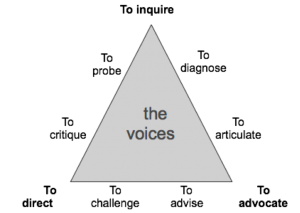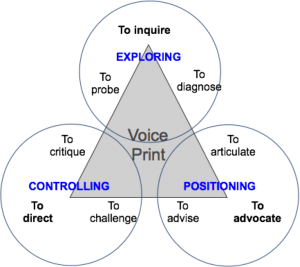The overall ambition of VoicePrint is to enable people to become ‘talk-wise’, improving the quality of communication and interaction by creating in-the-moment awareness and skill in the use of talk and listening. We don’t remember how we learnt to talk, we just picked it up. As a result, we don’t think a great deal about how we do it now. So, we need to give it more attention to ensure that our impact matches our intent.
We talk a lot about communication. It’s often the top problem in employee attitude surveys and continues to be problematic. This suggests we need to do something differently, and that there is space for something that tries to tackle the problem head on.
VoicePrint is a tool for developing people. It originated as a model of competence in the use of talk. From that, we developed the questionnaires to help people to recognise their distinctive approaches and impacts, because these are strongly influenced by personality. But the key objective is to improve what happens in practice. So VoicePrint goes beyond assessing current tendency to point out what can be done differently. In the hands of a skilful practitioner, it is a highly relevant, pragmatic and immediate way of developing individual, team and organisational performance.

VoicePrint provides a vital connection, bridging the gap between personality and behaviour.
- It focuses on an everyday activity and pivotal capability (talking) that is generally taken for granted.
- It provides a practical link between understanding personality and developing competence.
- It turns attention to the dynamics of behaviour rather than the statics of type, trait or attitude.
There are various components of the tool that are available (these will be covered in more detail in a later session):
1 – Self Perception profile – the profile generated by an individual completing the questionnaire.
2 – Relationship and group profiles – provide a picture of how two or more people communicate, by overlaying their individual profiles.
3 – 360 feedback profiles – take input from others and overlay with an individual profile to understand which voices are received by others.
The 9 Voices
Advise: To suggest a course of action or way of thinking
Advocate: To hold a personal view, either for or against
Articulate: To describe & clarify in a precise, neutral, matter-of-fact way
Challenge: To interrupt in order to improve what is happening
Critique: To assess thoroughly & objectively, considering both strengths & shortcomings
Diagnose: To analyse in order to come to an understanding
Direct: To call (or recall) attention to a responsibility, required standard or boundary
Inquire: To ask open-mindedly in order to find out more
Probe: To dig deeper, going beyond or behind what is already apparent

There are three clusters of voices in the VoicePrint model:

Each voice has a dark side, which emerges when the voice is used badly. These are:
Advise: Patronise
Advocate: Preach
Articulate: Verbose
Challenge: Attack
Critique: Criticise
Diagnose: Over-Analyse
Direct: Dictate
Inquire: Interrogate
Probe: Intrude
